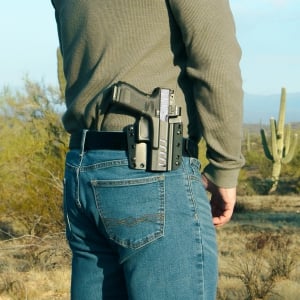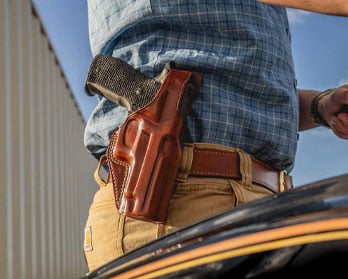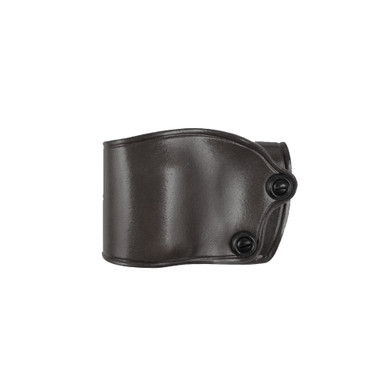The Pros and Cons of Different Materials Used in Holsters
When it comes to holsters, there are a lot of different materials that can be used. Each material has its own set of pros and cons, so it's important to choose the right one for you. In this guide, we'll take a look at the most popular materials used in holsters and see what their strengths and weaknesses are. With this information, you'll be able to make a more informed decision about which holster is right for you.
Popular Holster Materials
Though holsters may vary significantly in styles and forms, the choice of materials is pretty limited. There are three primary materials used for holster-making: Kydex, leather and nylon. Kydex is known for its durability and very slack maintenance requirements. Leather is also praised for its robustness and ever-classic style as well as flexible design. Nylon is also a popular material due to its affordability and versatile nature. Cloth holsters are also present on the market, though they can boast the popularity of the abovementioned holsters. They don’t lack appeal, but they are not designed to handle daily use in the way that the three materials are.
Kydex Holsters

Kydex holsters offer a combination of features that any gun owner can appreciate. Firstly, they are known for retaining their shape even after years of use, so you can consider getting a Kydex holster a long-term investment. They also have no break-in period, meaning your gun will fit right in from the beginning. They're also lightweight and quite affordable, so you won't need to break the bank to get one. Of course, every product comes with downsides - drawing from Kydex holsters is noisier than from other holsters, so discretion might not be their forte. At the same time, their robustness can backfire/ Rigid Kydex can wear against the finish of your gun. All in all, however, Kydex holsters are a great value option that holds up to daily wear while providing reliable performance.
Leather Holsters

Leather holsters are considered iconic by many people, in part because these holsters are fancied by the television and cinematography. They are the most flexible option for carrying a gun with you. Leather holsters naturally form to your body after a while, allowing for a more comfortable and personalized carrying experience. Drawing from a leather holster is very quiet, so most people acquire them for concealed carry. However, because of the material's natural friction, drawing from a leather holster is often longer than with other options. As such, practice is necessary to ensure quick response. Additionally, leather holsters are more prone to wear than synthetic holsters and require more thorough maintenance. However, the connoisseurs of the classic will tell you that no synthetic holster will ever compare to a leather one.
Nylon Holsters
Nylon holsters make for the cheapest option on the market and there are some pros and cons related to that fact. Nylon holsters are not molded for a particular gun model, which earns them the title of the most universal holster material. Such holsters can fit multiple models of guns in a given size range. They are also the quietest of the three and allow for a quick draw. The durability of nylon holsters depends on the thickness of the material. Thin nylon is known to wear off quicker than other materials, but you can go for pricier high-denier nylon. This material is usually used in OWB and shoulder holsters, so the choice of nylon options is somewhat restricted.
Cloth Holsters
Cloth holsters can’t boast the popularity of other holsters, but they do offer some unique advantages that other holsters don’t. One of the biggest benefits of cloth holsters is their lightweight design. They're easy to carry and don't weigh down the user as other holsters might. In addition, cloth holsters come in a variety of colors and patterns so you can choose one that matches your style.
On the downside, cloth holsters may not provide the same level of protection or stability as other materials. For example, the material may be prone to wear and tear over time or may not offer enough grip when drawing and re-holstering your firearm. Additionally, if your holster gets wet it won't provide adequate protection for your firearm.
Overall, cloth holsters are worth a shot in some particular cases. But they should only be used if you don't need superior protection and stability from your holster.
Which Holster Material is Right for You?
As you can see, the qualities of a holster depend heavily on the material it’s made of. None of the materials, however, is superior to the other. The key to finding a suitable holster is prioritizing your personal needs. It's essential to consider the feel of the material as some may prove to be too rigid for you or not molded enough for your desired fit. The price range can also be a deciding factor; if you are on a tight budget, synthetic materials are often more affordable than leather or high-end composites. Finally, consider maintenance: do you want something that requires close-to-none maintenance or are you ready to acquire a maintenance routine? By considering all those factors, you will be able to find the best holster material.
FAQs
Which holster material is the most durable and robust?
Kydex is often considered to be more durable than other materials, but leather and nylon holsters still offer sufficient protection and stability. Kydex tends to wear out quicker than leather holsters and may not last as long over time, so it is important to consider all types of materials when selecting a holster.
What factors should be considered when selecting a holster material?
The main factors to consider are durability and longevity, comfort, cost, concealability, and ease of maintenance. Durability and longevity are crucial factors, as certain materials may be less likely to wear or tear over time. Comfort is another important factor as some materials may be more comfortable against the body than others. Cost can’t be ignored either; some materials may be more expensive than others due to the material’s quality or availability. Concealability should also be taken into account when selecting a concealed carry holster; certain materials may make it easier to conceal a handgun than others. Lastly, there is ease of maintenance; some materials may require more maintenance than others in order to remain durable and functional over time.
Is there a difference in comfort between different holster materials?
Yes, there is a difference in comfort between different holster materials. Some materials like leather and cloth may be more comfortable against the body than others, so it is important to consider comfort when selecting a holster material.
What is the most affordable holster material?
The most affordable holster material is typically nylon or polyester. These materials are less expensive than leather and Kydex and are often found in budget holsters.
How do different holster materials affect gun retention and security?
Holsters made of different materials can have a significant impact on gun retention and security. Leather holsters typically provide good retention as the material is often stiff and can be molded to the shape of the gun's handle. Kydex holsters offer excellent retention, as the hard material is formed to fit the specific make and model of a gun, providing a snug fit. The retention capabilities of Nylon holsters are somewhat inferior to theirs but are nonetheless sufficient.
Recent Posts
-
Echelon 4.0C Launch and Its Impact on Handgun Design
Recently, Springfield released the new Echelon 4.0C (aka Echelon Compact) 9mm pistol. Read to lear …Dec 18th 2024 -
The End of an Era: Why Cheaper Than Dirt Stopped Selling Guns
Recently, Cheaper Than Dirt, a major online gun store based in Fort Worth, made headlines by steppin …Oct 24th 2024 -
A Guide to Hunting, Sporting & AR-15 Rifle Barrels
In this post, we’re discussing rifle barrel types in terms of materials, finishes, profiles, twis …Jun 11th 2024














